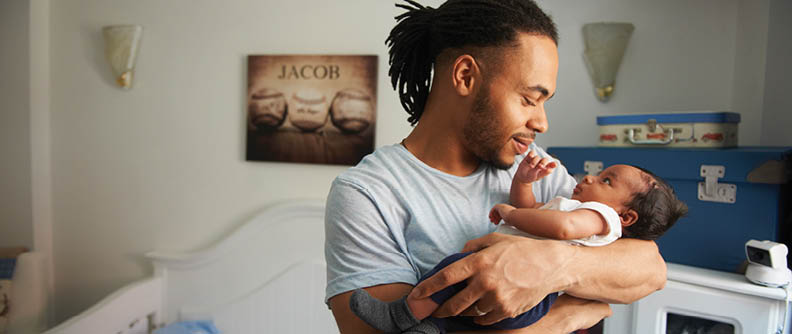Learning basic newborn care before baby arrives can help you feel more prepared. Here are some important tips to keep in mind.
Cleaning your baby
You’ll need to give your baby occasional sponge baths until the umbilical cord stump falls off. There’s no need to bathe your baby every day. However, you should clean your baby’s diaper area with every diaper change.
Be sure to have everything ready for the bath before getting started. Always keep a hand on your baby for safety, and don’t ever leave them alone.
You can wrap your baby in a soft towel or blanket and work on one area at a time. Start with their face. With a warm, damp washcloth, wipe their nose, ears, and eyes. When you move on, clean the body in small sections, and be sure to clean the creases under your baby’s arms and neck, and to carefully clean their genitals.
After the umbilical cord stump falls off, it’s okay to give your baby a bath in the sink or in a shallow bathing tub. Fill a clean sink or tub with 2-3 inches of warm water. Support their head, and use a gentle, unscented shampoo to wash the hair. Then, wash your baby’s body with a gentle baby soap. Rinse your newborn off completely and pat them dry with a soft towel. You don’t need to use lotion, but you might choose to — just be sure it’s gentle and unscented.
It’s important to keep your baby’s umbilical cord stump clean and dry until it falls off. There is no need to put any other products on the umbilical cord stump to help it heal.
Common skin conditions
As you wash your newborn, you have a good opportunity to look at their skin. Be sure to note any changes, but keep in mind that most skin changes aren’t a cause for concern.
Common skin conditions include:
- Baby acne
- Blotchy, red skin
- Dark blue mark on the lower back or buttocks
- Dry, flaky skin
- Flaky scalp, sometimes called “cradle cap”
- Reddish marks around the forehead, eyes, or the back of the neck
- White bumps
If you’re concerned about any skin changes, be sure to let your baby’s clinician know.
Caring for nails
Like adults, baby nails usually grow quickly. Use baby nail clippers or a baby nail file to carefully trim nails back. It might be easier to do this while your baby sleeps.
How often will my baby eat?
Babies feed frequently, usually at least 8 to 12 times in 24 hours, or about every 2 to 3 hours. In the first day or two, your baby might only have one wet diaper and one stool each day. This number will increase during your first week at home. Your baby should soon have 3 or more wet diapers every 24 hours. That number will go up over time. An increasing number of wet diapers every day helps you know you’re feeding your baby enough.
Changing diapers
Your baby’s first stool is called meconium. It’s dark, sticky, and usually green. This will change over the first few days. If you breastfeed your baby, you’ll likely need to change several stool-filled diapers during the day. Formula fed babies usually produce one stool every day to every other day.
It’s important to always wipe your baby’s vaginal area front to back to avoid urinary tract infections. Your baby may also have swollen breasts and labia. Some have milky or slightly bloody discharge from the vagina. This is all normal.
Be sure to cover your baby’s penis with a clean diaper or cloth while changing. This is in case your baby urinates while you’re changing the diaper. If your baby isn’t circumcised, you don’t need to do anything special to keep the area clean. Be sure to be gentle with your baby’s foreskin, and don’t pull it back.
If your baby is circumcised, gently wipe the tip of the penis with warm water. Your baby may have a plastic ring around the head of the penis — this should fall off within 4 to 10 days. Use petroleum jelly if your clinician recommends it. Also, it’s normal for the penis to have a black or brown crust as it heals.
Follow-up visits
Follow-up care is important for making sure your baby stays healthy. The first well-child visit, or checkup, usually occurs when your baby is around 2 days old. After that, your baby should have a checkup at 2 weeks, 2 months, 4 months, and 6 months.
At each checkup, your baby will be weighed, measured, and examined. You’ll also have a chance to ask questions — it might help to bring a list of questions so you don’t miss anything.
Finally, well-baby visits help you keep up with immunizations. Your child will receive a hepatitis B vaccination after birth. Then, they will receive more vaccinations at 2 months.
When to contact baby’s doctor
Be sure to let your baby’s clinician know if your baby has:
- A fever of 100.4 degrees or higher
- Pus-filled blisters
- Redness, pain, or swelling that doesn’t get better
- Spots of blood in the diaper larger than a quarter
These may all be signs of infection and should be addressed immediately.
